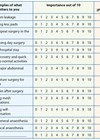In Western countries, we are spoilt for choice in almost every aspect of our lives, but does that reflect also in healthcare? While we have taken some big strides towards shared decision-making with our patients, the age-old physician dominance remains alive and kicking. In this article we investigate the subject of shared decision-making and explore various ways of implementing such concepts in our surgical practice.
Patient involvement is one of the three ‘pillars’ of evidence-based medicine, according to David Sackett [1]. Along with scientific evidence, and our own experience, we explore the patient perspective to facilitate coaching in making the decision that is right for them.

Interpreting scientific evidence has become easier than ever thanks to artificial intelligence (AI) models and ease of access to information. It is noteworthy to remind ourselves, however, that the various AI tools currently out there are largely ‘language’, rather than ‘knowledge’ models. Our patients have almost equal access to these models as we do, and ‘Dr Google’ has been recently replaced by ‘Prof GPT’. It is quite possible that our average patient will not know that ChatGPT, and similar large language models (LLM), can ‘hallucinate’ and provide wrong answers, complete with fake scientific references. An AI model that is based on sound scientific knowledge appears to be on the horizon e.g., Anna the robot [2].
The National Institute for Health and Care Excellence (NICE) published its first guidance on shared decision-making (SDM) in June 2021 [3]. NICE defines SDM as a “collaborative process that involves a person and their healthcare professional working together to reach a joint decision about care. It involves choosing tests and treatments based both on evidence and on the person’s individual preferences, beliefs and values. It means making sure the person understands the risks, benefits and possible consequences of different options through discussion and information sharing.”
Shared decision-making should not be viewed as a move away from ‘doctor knows all’. Instead, surgeons need to ensure they have a true understanding of what matters to a patient coming to clinic and use their knowledge and experience to properly communicate information about risks and alternatives. We must not forget the challenge of SDM is not only philosophical, but also logistical in addressing different cultures and different languages. The European Association of Urology (EAU) has published a patient information site with various languages to address this [4]. Understanding individual patient preferences, beliefs and values is a fundamental component of SDM. How can this take place within the constraints of limited consultation time? An AI model that summarises an individual patient’s beliefs and values based on their answers to specific questions would perhaps be a game changer.
"Understanding individual patient preferences, beliefs and values is a fundamental component of SDM"
‘Necessity is the mother of all invention and innovation’; this can certainly be applied to patient decision aids (PDAs). There are significant variations in the availability of PDAs per condition and usually dictated by either the increase in treatment options or as a result of complications. While there are several reliable PDAs for prostate cancer [5], for example, there are very few, if any, for overactive bladder or painful bladder syndrome. We have seen a flurry of PDAs in stress urinary incontinence surgery [6,7] and management of transvaginal mesh complications. Similarly, with the introduction of many new minimally invasive technologies for men with benign prostatic obstruction, NHS England has recently published a PDA on treatment options for men with this condition [8]. PDAs should be translated into several languages and should not be behind a paywall. Wider adoption of a validated tool created for our patients is a necessary investment for the future of SDM.
A 2013 BMJ article described patient information leaflets as “a stupid system” [9]. Smart illustrations, however, can be key for clear information delivery and can make these leaflets so much more effective. A videoclip demonstrating all available options for a specific condition may be more valuable than one that focuses on only one intervention [10].
PDAs are the way to go in decision ‘coaching’. The most robust decision quality assessment tool is the Decisional Conflict Scale (DCS). Patient reported outcome measures (PROMs) and patient reported experience measures (PREMs) can however be tedious and lengthy for patients to complete. To reduce the burden, a shorter intelligent questionnaire could be used e.g., the four-item ICIQ-UI-SF and the four-item DCS instead of a 16-item one. A clever animation of the questionnaire can also be helpful in reducing the burden, for example the animation stops to ask the question and once answered, the animation restarts with the next message, followed by the next question.
It is a significant time commitment for clinicians, researchers and patients to collaborate on developing reliable PDAs. The process ideally follows the SUNDAE Statement (Standards for UNiversal reporting of patient Decision Aid Evaluation studies) [11] in conducting and reporting studies evaluating PDAs in clinical settings.
Currently, various AI tools appear to promise to adequately address only one aspect of evidence-based medicine, which is the research evidence. Better ability to summarise the evidence, and answer specific clinical questions without ‘hallucinations’, would be more useful. Eliciting individual patient values, however, is currently receiving less focus by AI developers. Such a tool would be truly valuable to clinicians whose time is the greatest commodity.
We need to recognise that surgeons and patients can have different viewpoints. For example, we, as surgeons, appear to place most value on the success of the treatment. Although no surgeon is immune to complications in their practice, interventions are relatively safe in the hands of experienced practitioners. Many of our patients, however, view things differently. Twenty years ago, a qualitative exercise in women’s choice of surgery for stress urinary incontinence reported that most women would trade efficacy for safety and a quicker recovery [12]. In other words, most would choose a less effective option, as long as it is safer and less invasive. Compared to effectiveness, safety and invasiveness were valued more highly for most participants in this study at the time, and indeed this is still true today [13].
Another difference in perception between patients and healthcare providers, is that of invasiveness. A qualitative study [14] suggested an intervention seen by clinicians as “minimally invasive”, was perceived as “highly invasive” by some patients – as it involved the implantation of a permanent medical device. While we largely perceive invasiveness in terms of access to the surgical field, laparotomy vs. laparoscopy for example, the implantation of a permanent medical device may not always feed into our definition of invasiveness.
It is not disputed that there are negative clinical consequences to poor quality decisions. This will be borne in terms of decision regret, adverse events, need for further treatment and overall lower quality of life in some patients. In addition, there are also medicolegal consequences, and all these factors are not conducive to the successful surgical practice we aspire to. While a poor quality decision, in itself, could amount to substandard practice, the causation scenario remains essential for a legal claim to succeed. The “counterfactual” is a legal term used in the clinical negligence field that asks the hypothetical question of what would the outcome have been had the decision quality been up to the standard.
The 2015 Montgomery ruling [15] has certainly changed patient consultations in the UK. Along with the reasonable doctor, the reasonable person and the reasonable patient can legally determine which risks are significant enough to be communicated prior to an intervention. Offering all available alternatives, however, remains our own territory and poses a heavy ethical requirement, rather than a legal one. An attempt to extrapolate Montgomery into the reasonable alternatives i.e., to allow the reasonable person and patient to determine the reasonable alternative, failed in the UK Supreme Court last year [16]. The Court confirmed that, unlike the legal test that applies to risks, only the medical professionals could legally determine the reasonable alternatives. This places a significant ethical responsibility on us, professionals, to explore what would be reasonable with our own patients knowing that.
Our challenges are to address our own biases in interpreting the scientific literature, as well as the inevitable biases created by our own experiences. A possible antidote is to introduce robust interventions into our armamentarium, which is key to offer the alternatives in a balanced way. If we only have a ‘hammer’ most conditions will look like ‘nails’ and, inadvertently or subconsciously, we will find it difficult to genuinely share the decision with our patient. While we may know better about a specific treatment for a specific condition, a patient knows better whether such treatment would be acceptable in their own situation. In some situations, there is a good possibility that no treatment (i.e., doing nothing) might be the right course of action.
It is key to invest time in the beginning to avoid subsequent decisional regret and adverse outcomes due to a poor decision process. It may be true that our health system is not currently conducive to a high-quality shared decision-making process. However, we do have most of the basic tools to engage in a well-conducted process.
The advent of technology, particularly AI, is expected to help automate shared decision-making e.g., by clearly communicating the patient’s values. However, no AI system will replace the unique doctor-patient relationship or replace the empathy that is key to futureproof our surgical practice.
References
1. Sackett DL, Rosenberg WM, Gray JA, et al. Evidence based medicine: what it is and what it isn’t. BMJ 1996;312(7023):71–2.
2. Khan A. Anna by MetaDoc.
https://www.youtube.com/watch?v=oyIppl2qgMs
3. NICE. Shared Decision Making [NG197]. 2021.
https://www.nice.org.uk/guidance/ng197.
4. EAU. Patient information site 2024.
https://patients.uroweb.org.
5. Ankolekar A, Vanneste BGL, Bloemen-van Gurp E, et al. Development and validation of a patient decision aid for prostate cancer therapy: from paternalistic towards participative shared decision making. BMC Med Inform Decis Mak 2019;19:130.
6. NHS Ayrshire & Arran. What Matters to you when Choosing Surgery for Stress Urinary Incontinence? Patient Decision Aid (SUI-PDA©). 2017.
https://www.nhsaaa.net/media/3152/
20171109stressincon.pdf.
7. NICE. Surgery for stress urinary incontinence patient decision aid. 2019.
https://www.nice.org.uk/guidance/
ng123/resources/surgery-for-stress
-urinary-incontinence-patient-decision
-aid-pdf-6725286110.
8. NHS England. Decision support tool: making a decision about enlarged prostate (BPE). 2023.
https://www.england.nhs.uk/publication/
decision-support-tool-making-a-decision
-about-enlarged-prostate-bpe/.
9. McCartney M. Patient information leaflets: ‘a stupid system’. BMJ 2013;347:f4748.
10. Science Animated. How to stop my bladder leaking? Surgery for stress urinary incontinence in women. 2021.
www.youtube.com/watch?v=rKRrSV0QVMk
11. Sepucha KR, Abhyankar P, Hoffman AS, et al. Standards for UNiversal reporting of patient decision aid evaluation studies: the development of SUNDAE checklist. BMJ Qual Saf 2018;27(5):380–8.
12. Robinson D, Anders K, Cardozo L, et al. What do women want? Interpretation of the concept of cure. J Pelvic Med Surg 2003;9(6):273–7.
13. Dwyer L, Weaver E, Rajai A, et al. “Voice your choice”: a study of women’s choice of surgery for primary stress urinary incontinence. Int Urogynecol J 2020;31(4):769–777.
14. Ong HL, Sokolova I, Bekarma H, et al. Development, validation and initial evaluation of patient-decision aid (SUI-PDA©) for women considering stress urinary incontinence surgery. Int Urogynecol J 2019;30:2013–22.
15. The UK Supreme Court. Montgomery v Lanarkshire Health Board [2015] UKSC March 2015.
16. The UK Supreme Court. McCulloch v Forth Valley Health Board [2023] UKSC June 2023.
All links last accessed March 2024.









